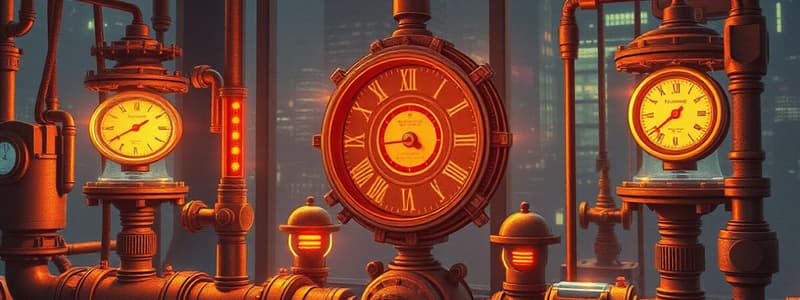Podcast
Questions and Answers
What would be the 'mA' signal for an electronic pressure transmitter reading 687 lbs if it is scaled to read between 500 and 1000 lbs?
What would be the 'mA' signal for an electronic pressure transmitter reading 687 lbs if it is scaled to read between 500 and 1000 lbs?
- 12.3 mA
- 10.7 mA
- 14.1 mA (correct)
- 16.5 mA
If the 'mA' signal for an electronic pressure transmitter reads 14, what pressure would it indicate?
If the 'mA' signal for an electronic pressure transmitter reads 14, what pressure would it indicate?
- 850 lbs
- 950 lbs
- 750 lbs (correct)
- 550 lbs
What would the 'mA' signal be for an electronic temperature transmitter reading 425 degrees Fahrenheit if it is scaled between 200 and 800 degrees Fahrenheit?
What would the 'mA' signal be for an electronic temperature transmitter reading 425 degrees Fahrenheit if it is scaled between 200 and 800 degrees Fahrenheit?
- 12.5 mA (correct)
- 8.2 mA
- 16.0 mA
- 10.0 mA
What temperature reading corresponds to a 'mA' signal of 14 on the same transmitter scaled between 200 and 800 degrees Fahrenheit?
What temperature reading corresponds to a 'mA' signal of 14 on the same transmitter scaled between 200 and 800 degrees Fahrenheit?
If a level transmitter with a range from 0 to 100% sends a signal of 7 mA to the level controller, what is the level in the vessel?
If a level transmitter with a range from 0 to 100% sends a signal of 7 mA to the level controller, what is the level in the vessel?
What would be the level in a vessel if a pneumatic transmitter sends a signal of 8 psi to the level controller (range from 0 to 100%)?
What would be the level in a vessel if a pneumatic transmitter sends a signal of 8 psi to the level controller (range from 0 to 100%)?
If a delta p flow transmitter indicates a signal of 'zero', what does this signify about the flow rate?
If a delta p flow transmitter indicates a signal of 'zero', what does this signify about the flow rate?
For a flow transmitter scaled to read from 0 to 50 gpm, what is the flow rate at a delta p of 15 psi?
For a flow transmitter scaled to read from 0 to 50 gpm, what is the flow rate at a delta p of 15 psi?
In a standard I/P transducer, 12 mA input signal corresponds to which psig of output signal?
In a standard I/P transducer, 12 mA input signal corresponds to which psig of output signal?
Which process variable primary sensor signals in 'milli-volts'?
Which process variable primary sensor signals in 'milli-volts'?
What does a differential pressure transmitter measure?
What does a differential pressure transmitter measure?
Which statement about an open control loop is accurate?
Which statement about an open control loop is accurate?
What is represented by 'live zero' in the mA scale?
What is represented by 'live zero' in the mA scale?
In a closed control loop, what device compares the 'pv' to the 'sp'?
In a closed control loop, what device compares the 'pv' to the 'sp'?
How does pressure affect the boiling point of a material?
How does pressure affect the boiling point of a material?
What characteristic do digital signals exhibit?
What characteristic do digital signals exhibit?
What is the common output signal of electronic analog devices?
What is the common output signal of electronic analog devices?
In the context of a pneumatic level transmitter, what does a 6 psi signal communicate?
In the context of a pneumatic level transmitter, what does a 6 psi signal communicate?
What type of signals are powered by air or gases?
What type of signals are powered by air or gases?
What is a transducer used for?
What is a transducer used for?
Flashcards are hidden until you start studying
Study Notes
Electronic Signals
- Standard electronic pressure transmitters output a current signal (in mA) corresponding to specific pressure readings.
- For a transmitter scaled from 500 to 1000 lbs, a pressure reading of 687 lbs translates to a current signal of approximately 10.5 mA.
- If a current signal of 14 mA were received, the corresponding pressure reading would be approximately 875 lbs.
- Electronic temperature transmitters typically operate within a scale, such as 200 to 800 degrees Fahrenheit.
- A temperature reading of 425 degrees F yields a current signal of about 10.625 mA from the temperature transmitter.
- A current signal of 14 mA from the same temperature transmitter would indicate approximately 650 degrees Fahrenheit.
- A level transmitter that sends a 7 mA signal indicates a level of approximately 7% in a vessel with a 0-100% range.
Pneumatic Signals
- Pneumatic transmitters operate under pressure measurements and can indicate levels in a vessel.
- A pneumatic transmitter signal of 8 psi corresponds to a vessel level of approximately 80%.
- If the level indicates 83%, the corresponding psi signal would be around 8.3 psi.
- A delta P flow transmitter signaling zero indicates the flow rate is zero, confirming no flow.
- For a flow transmitter scaled from 0 to 50 gpm with a maximum delta p of 100 inches of water, a flow rate at 15 psi would be about 7.5 gpm.
- In an I/P transducer, a 12 mA input signal typically corresponds to around 25 psig of output.
4-20 mA Transmitter
- For a 4-20 mA transmitter, the relationships between psi and mA output signals must be defined.
- At 0% level, 3 psi aligns with 4 mA; while for 100% level, it corresponds to 100 psi and 20 mA.
- Process variables that transmit signals in millivolts include temperature sensors.
Additional Concepts
- "Live zero" represents a minimum output signal from transmitters even with zero input, ensuring systems remain responsive.
- Pressure, temperature, level, and flow sensors are common types of transducers due to their reliability and accuracy.
- LRV (Lower Range Value) and URV (Upper Range Value) define the operational limits of measuring devices.
- Numerical equivalence between scales is termed "scaling."
- Differential pressure transmitters measure the difference between two pressure points, vital for understanding system dynamics.
- Control loops consist of sensors, controllers, and final control elements to regulate process variables.
Control Loop Mechanics
- An open control loop does not provide feedback, unlike a closed loop which continuously monitors process values.
- Transducers convert physical phenomena into readable signals for controllers.
- pneumatic signals—typically between 3-15 psi—represent the control signal range.
- Electrical signals often utilize the 4-20 mA standard for analog control systems.
- Digital signals are based on microprocessors and employ binary inputs and outputs for processing data.
Fluid Dynamics Considerations
- In an open tank, increased temperature leads to a rise in fluid volume, affecting pressure and density.
- Increased pressure elevates the boiling point of materials, a principle relevant in thermodynamics.
- Analog systems reflect continuous changes, while digital systems present discrete value shifts.
- Pneumatic instruments utilize air or gases to operate and transmit information.
- Standard pneumatic signals typically operate around 3-15 psi.
- Differential pressure represents the difference calculated between static and dynamic fluid pressures.
Additional Calculations and Principles
- Head pressure can be calculated using fluid height, specific gravity, and equivalent formulas.
- Changes in temperature directly impact both volume and head pressure in fluid systems, illustrating thermodynamic behavior.
- According to Bernoulli's principle, an increase in fluid speed results in a drop in fluid pressure, crucial for understanding fluid dynamics and system design.
Studying That Suits You
Use AI to generate personalized quizzes and flashcards to suit your learning preferences.



